
Picture your garden as a masterpiece, with perennials as the enduring strokes of color that transform each season into a new chapter of beauty.
These remarkable plants come back stronger every spring, filling your landscape with lush foliage and vibrant blooms.
While annuals provide quick bursts of charm, perennials deliver lasting elegance, maturing and expanding year after year.
By understanding USDA hardiness zones, sunlight needs, and soil conditions, you can design a garden that flourishes season after season.
This guide is here to help you navigate the wonderful world of perennials and inspire you to cultivate a garden that thrives with color, texture, and timeless beauty. Let’s dig into the secrets of creating a truly enduring and rewarding garden.
Bring Shaded Spaces to Life with Hostas

| Quick Care Guide | Details |
|---|---|
| Climate Zones | USDA Zones 3-9 |
| Sun Requirements | Partial shade to full shade |
| Soil | Well-drained, rich in organic matter |
| Watering Needs | Moderate; keep soil consistently moist, but avoid waterlogging |
| Common Companion Plants | Ferns, Astilbe, Coral Bells (Heuchera), Bleeding Hearts, and Japanese Forest Grass (Hakonechloa) |
Turn the dim corners of your yard into a lush haven with the dependable and elegant Hosta. These shade-loving perennials thrive in those tricky spots—under trees, along north-facing walls, or anywhere sunlight is sparse.
With their striking leaves in shades of blue, green, chartreuse, and white, Hostas add a vibrant pop of color where you least expect it.
The textured foliage, ranging from crinkled to cup-shaped, creates visual depth and interest, making Hostas a favorite for garden designs.
They’re incredibly easy to propagate too. Just divide their bulbs in the spring or fall to keep your plants healthy or to share with friends.
To keep them happy, plant them in well-drained soil, add a layer of mulch to retain moisture, and keep the weeds at bay.
Coral Bells: A Spectrum of Color for Every Corner
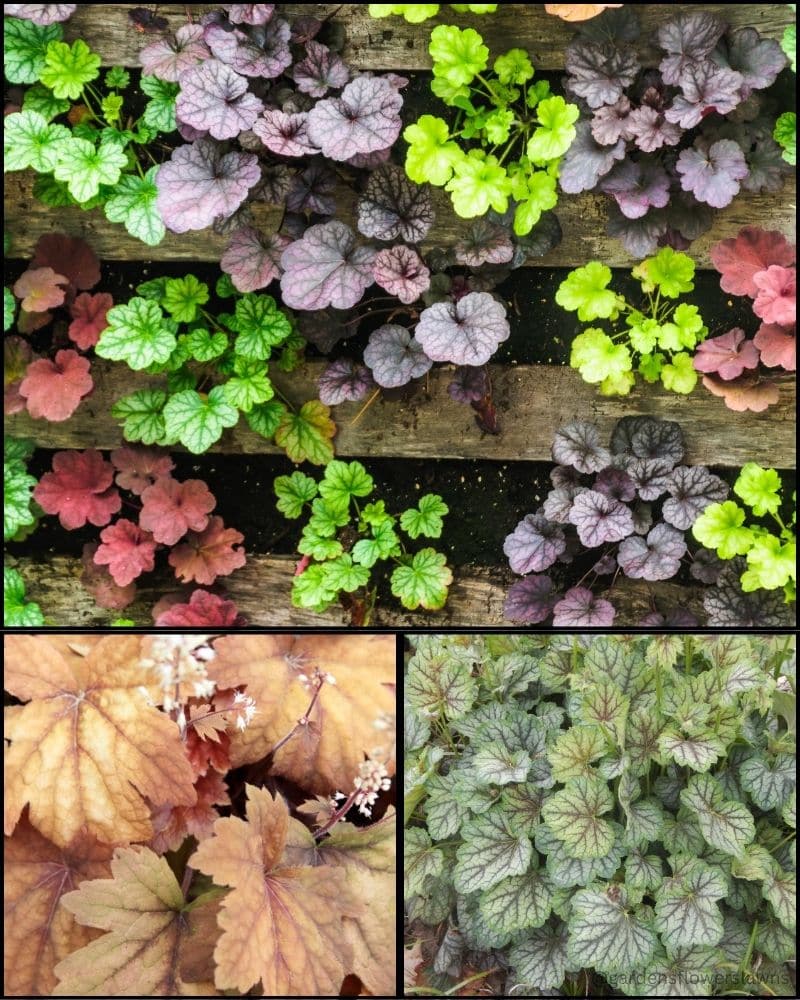
| Quick Care Guide | Details |
|---|---|
| Climate Zones | USDA Zones 4-9 |
| Sun Requirements | Full sun to full shade (varies by variety) |
| Soil | Well-drained, rich in organic matter |
| Watering Needs | Moderate; water regularly but avoid overwatering |
| Common Companion Plants | Hostas, Astilbe, Ferns, Lungwort (Pulmonaria), and Japanese Painted Ferns |
Coral Bells, or Heuchera, are the ultimate garden multitaskers, thriving in nearly any lighting condition—from full sun to deep shade.
These perennials bring a dramatic splash of color with their stunning foliage, which ranges from lime green and fiery red to deep purples and earthy ochres.
As an added bonus, they send up delicate flower spikes in late summer for a touch of elegance.
These easy-care plants are perfect for edging garden paths, filling mixed containers, or adding vibrant accents to shaded borders.
For best results, enrich your soil with organic matter to enhance their leaf color and ensure good drainage to prevent root rot.
Coral Bells are a durable and beautiful choice for adding year-round visual appeal to your garden.
Salvia: The Do it All Grow it Everywhere Choice

| Quick Care Guide | Details |
|---|---|
| Climate Zones | USDA Zones 4-10 |
| Sun Requirements | Full sun |
| Soil | Well-drained |
| Watering Needs | Low to moderate; drought-tolerant once established |
| Common Companion Plants | Coneflowers (Echinacea), Black-Eyed Susans (Rudbeckia), Yarrow, Lavender, and Gaillardia |
Salvia, part of the mint family, is a standout in any garden with its sage-like leaves and vibrant flowers in shades of blue, red, and more.
Perfect for creating a splash of patriotic color at a Fourth of July gathering, this plant is as practical as it is beautiful, being deer-resistant and low-maintenance.
The silver-grey foliage offers a striking contrast to traditional green backdrops, adding texture and dimension.
For best results, plant Salvia in well-drained soil under full sun. Regular deadheading will promote continuous blooms throughout the summer, keeping your garden lively and colorful.
Yarrow: Timeless Beauty with a Hardy Nature

| Quick Care Guide | Details |
|---|---|
| Climate Zones | USDA Zones 3-9 |
| Sun Requirements | Full sun |
| Soil | Well-drained; tolerates poor soil conditions |
| Watering Needs | Low; drought-tolerant once established |
| Common Companion Plants | Lavender, Coneflowers (Echinacea), Black-Eyed Susans (Rudbeckia), Coreopsis, and Salvias |
Yarrow (Achillea millefolium) is a plant steeped in history, named for the legendary hero Achilles, who is said to have used it for its medicinal properties.
In modern gardens, Yarrow is beloved for its bushy, low-maintenance growth and vibrant clusters of flowers in shades of white, yellow, and red.
This hardy perennial thrives in well-drained soil and full sun, making it an excellent choice for dry, sunny spots. Wear gloves when handling Yarrow, as it can sometimes cause a light-sensitive skin reaction.
Perfect for borders or as a dried bouquet flower, Yarrow brings both charm and ancient elegance to your garden.
Sedum: A Hardy and Drought-Resistant Gem

| Quick Care Guide | Details |
|---|---|
| Climate Zones | USDA Zones 3-9 |
| Sun Requirements | Full sun |
| Soil | Well-drained; tolerates sandy and rocky soils |
| Watering Needs | Low; thrives in drought conditions |
| Common Companion Plants | Ornamental Grasses, Coneflowers (Echinacea), Black-Eyed Susans (Rudbeckia), Lavender, and Thyme |
Sedum, with its succulent-like leaves, is an exceptionally resilient and visually striking choice for your garden.
These plants, often called “stonecrop,” feature rubbery foliage that adds unique texture and color to landscapes.
Many Sedum varieties are so hardy they can withstand the freezing temperatures of regions like North Dakota.
Sedum blooms attract bees and butterflies, making it a vital addition to pollinator-friendly gardens. With its array of leaf shapes and flower colors, Sedum fits seamlessly into diverse garden styles.
To ensure thriving growth, plant Sedum in well-drained soil with plenty of sunlight. Its low water needs make it ideal for drought-prone areas or gardeners looking for easy-care options.
Coneflowers: A Drought-Tolerant Delight
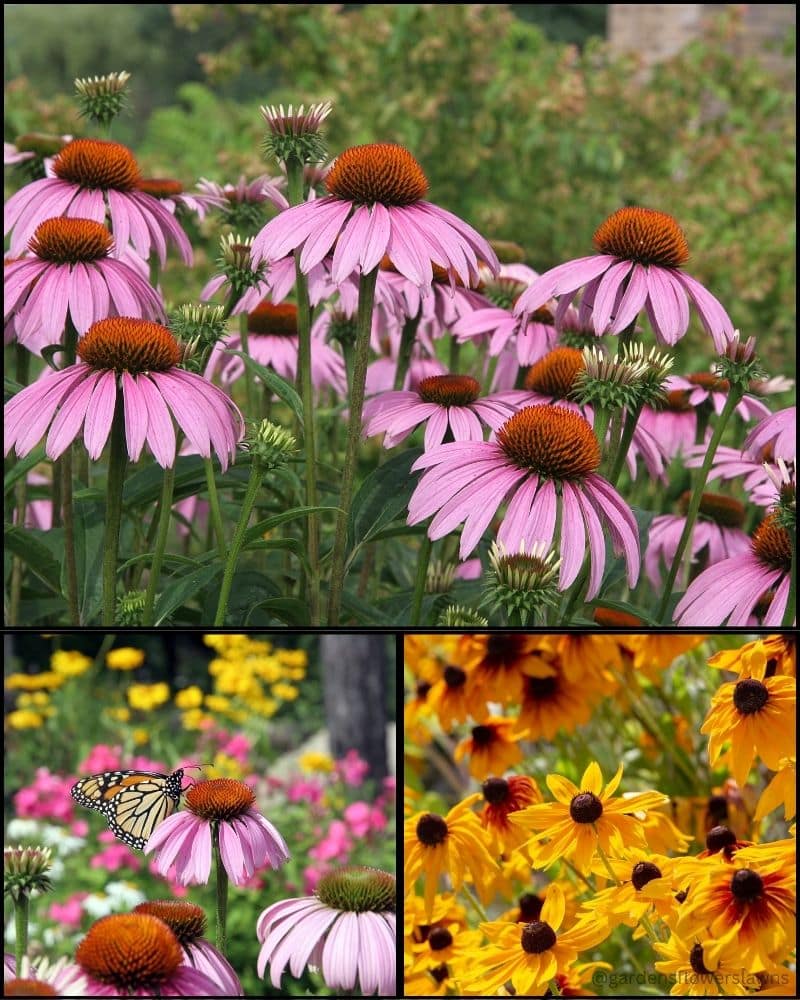
| Quick Care Guide | Details |
|---|---|
| Climate Zones | USDA Zones 3-9 |
| Sun Requirements | Full sun |
| Soil | Well-drained; tolerates poor and rocky soils |
| Watering Needs | Low; drought-tolerant once established |
| Common Companion Plants | Yarrow, Black-Eyed Susans (Rudbeckia), Salvias, Lavender, and Coreopsis |
Coneflowers, like Echinacea and Rudbeckia, are shining examples of hardy, low-maintenance plants that add cheerful color to any garden.
Famous for their daisy-like flowers in hues ranging from classic purple to sunny yellows and fiery oranges, they stand up to heat and dry conditions with ease.
Echinacea, in particular, is also celebrated for its use in herbal remedies, adding practical value to its beauty.
These pollinator favorites are perfect for bringing in butterflies, bees, and birds, creating a lively and vibrant garden scene.
For best results, plant coneflowers in a sunny spot with well-drained soil. Snipping off spent flowers (deadheading) will promote more blooms, extending their showy display.
Collecting seeds from coneflowers is simple and a great way to expand your garden while enjoying a fun wintertime hobby.
Bee Balm: A Pollinator’s Paradise

| Quick Care Guide | Details |
|---|---|
| Climate Zones | USDA Zones 3-9 |
| Sun Requirements | Full sun to partial shade |
| Soil | Well-drained, moderately rich in organic matter |
| Watering Needs | Moderate; prefers consistent moisture but can tolerate short dry spells |
| Common Companion Plants | Coneflowers (Echinacea), Black-Eyed Susans (Rudbeckia), Yarrow, Coreopsis, and Salvias |
Bee Balm, a standout in the mint family, is a magnet for pollinators like bees, butterflies, and hummingbirds. With its bright, tubular blooms in shades of red, pink, and purple,
Bee Balm brings a bold, wildflower charm to any garden. Native to North America, this perennial has a long history of supporting local ecosystems and pollinator species.
Its aromatic leaves, once used by Native Americans to flavor game, carry a unique herbal taste reminiscent of peppermint and oregano.
To help Bee Balm thrive, plant it in well-drained soil with full sun to partial shade. This versatile plant will quickly become a lively, colorful centerpiece in your pollinator-friendly garden.
Black-Eyed Susan: A Cheerful Summer Favorite

| Quick Care Guide | Details |
|---|---|
| Climate Zones | USDA Zones 3-9 |
| Sun Requirements | Full sun |
| Soil | Well-drained; tolerates sandy, rocky, or nutrient-poor soils |
| Watering Needs | Low; drought-tolerant once established |
| Common Companion Plants | Coneflowers (Echinacea), Salvias, Yarrow, Coreopsis, and Ornamental Grasses |
Black-Eyed Susan (Rudbeckia) brings a radiant burst of yellow to any garden, with its daisy-like petals and striking dark centers creating a stunning contrast.
This iconic summer bloomer is a must-have for gardeners looking to brighten their landscapes with vibrant, low-maintenance flowers.
These hardy perennials are drought-resistant and easy to grow, making them a favorite for sunny garden beds or wildflower meadows.
Black-Eyed Susans are also a hit with pollinators, drawing bees and butterflies to their cheerful blooms. For best results, plant them in a sunny spot with well-drained soil.
Their seeds are simple to harvest, providing an economical way to fill your garden with these sunny, enduring beauties year after year.
Coreopsis: The Sunny, Low-Maintenance Perennial
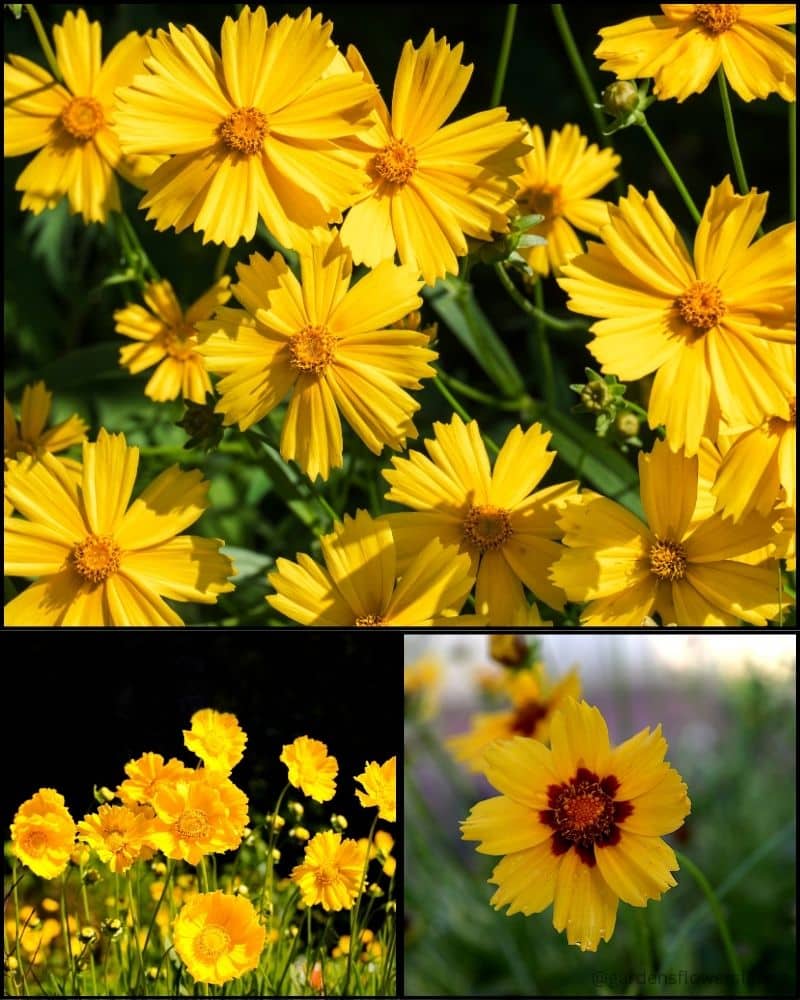
| Quick Care Guide | Details |
|---|---|
| Climate Zones | USDA Zones 4-9 |
| Sun Requirements | Full sun |
| Soil | Well-drained; tolerates poor and rocky soils |
| Watering Needs | Low to moderate; drought-tolerant once established |
| Common Companion Plants | Black-Eyed Susans (Rudbeckia), Coneflowers (Echinacea), Yarrow, Salvias, and Blanket Flowers (Gaillardia) |
Coreopsis, affectionately known as Tickseed, is a bright and cheery perennial that lights up gardens with its golden, daisy-like blooms.
Native to North America, this adaptable plant thrives in wildflower meadows and home gardens alike, adding vibrant yellow tones to any landscape.
Beloved by pollinators, Coreopsis also provides a habitat for certain caterpillars, making it an excellent choice for eco-conscious gardeners.
Its fine, delicate foliage adds texture to your garden, while its low-maintenance nature ensures it thrives with minimal care.
To enjoy a steady display of blooms, plant Coreopsis in full sun with well-drained soil, and let this sunny perennial brighten your garden while boosting its biodiversity.
Lavender: Fragrant Elegance for Any Garden

| Quick Care Guide | Details |
|---|---|
| Climate Zones | USDA Zones 5-9 (some hardy varieties can tolerate Zone 4 with protection) |
| Sun Requirements | Full sun |
| Soil | Well-drained, slightly alkaline, and sandy or rocky soils |
| Watering Needs | Low; prefers dry conditions once established |
| Common Companion Plants | Rosemary, Thyme, Coneflowers (Echinacea), Yarrow, and Ornamental Grasses |
Lavender, with its striking silvery-green foliage and iconic purple blooms, is a staple in both formal and cottage garden designs.
Known for its calming scent, Lavender adds a touch of tranquility to any outdoor space. A simple brush against its fragrant stalks releases its soothing aroma, creating a sensory experience as you move through your garden.
This resilient herb thrives in sunny locations with well-drained soil, making it an ideal choice for borders, pathways, or container planting.
Beyond its ornamental value, dried Lavender flowers are perfect for crafts, sachets, or culinary use, bringing the essence of Provence into your home.
Plant Lavender in full sun and ensure good drainage to encourage lush growth and abundant, aromatic blooms.
Daylilies: Stunning Blooms with a Caution

| Quick Care Guide | Details |
|---|---|
| Climate Zones | USDA Zones 3-9 |
| Sun Requirements | Full sun to partial shade |
| Soil | Well-drained; adapts to a variety of soil types |
| Watering Needs | Moderate; prefers evenly moist soil |
| Common Companion Plants | Coneflowers (Echinacea), Black-Eyed Susans (Rudbeckia), Coreopsis, Salvias, and Yarrow |
Daylilies captivate gardeners with their vibrant, thick-petaled flowers that come in a wide range of colors, from pure white to deep red.
Each bloom lasts only a day, but the plants produce multiple flowers over an extended period, ensuring a steady show of beauty. Their lush, spiked green foliage adds texture and interest even when the blooms are not present.
While daylilies thrive in well-drained soil and sunny locations, it’s essential to know that they are highly toxic to cats.
Gardeners with feline friends should consider alternative plants or keep daylilies out of reach. Pairing daylilies with long-blooming perennials ensures your garden remains colorful and dynamic throughout the season.
Ice Plant: A Dazzling Groundcover for Dry Gardens (warmer Climates Only)

| Quick Care Guide | Details |
|---|---|
| Climate Zones | USDA Zones 5-10 |
| Sun Requirements | Full sun |
| Soil | Well-drained, sandy, or rocky |
| Watering Needs | Low; drought-tolerant and requires minimal care |
| Common Companion Plants | Sedum, Thyme, Ornamental Grasses, Lavender, and Succulents |
The Ice Plant (Delosperma Cooperi) is a vibrant groundcover known for its succulent-like foliage and dazzling purple blooms.
Perfect for rock gardens, slopes, or dry areas, it thrives in full sun and well-drained soil. Its long-lasting flowers and low-maintenance nature make it a standout for colorful, drought-tolerant landscapes.
Shasta Daisy: A Timeless Summer Classic

| Quick Care Guide | Details |
|---|---|
| Climate Zones | USDA Zones 4-9 |
| Sun Requirements | Full sun to partial sun |
| Soil | Well-drained; tolerates sandy or average soil |
| Watering Needs | Moderate; drought-tolerant once established |
| Common Companion Plants | Coneflowers (Echinacea), Black-Eyed Susans (Rudbeckia), Yarrow, Lavender, and Coreopsis |
The Shasta Daisy is a quintessential summer flower, embodying warmth and cheer with its bright white petals and golden centers.
These resilient perennials shine through the heat of summer, continuing to bloom even when other plants retreat.
They are a versatile choice, thriving equally well in garden beds or as cut flowers for fresh or dried arrangements.
Shasta Daisies are low-maintenance and easy to grow, spreading generously to create cheerful meadows of blooms.
Plant them in well-drained soil with full to partial sun, and deadhead spent flowers to encourage an extended blooming period.
While their scent is best enjoyed outdoors, their visual charm brings a touch of classic beauty to any garden.
Speedwell: Vibrant Color and Adaptable Charm
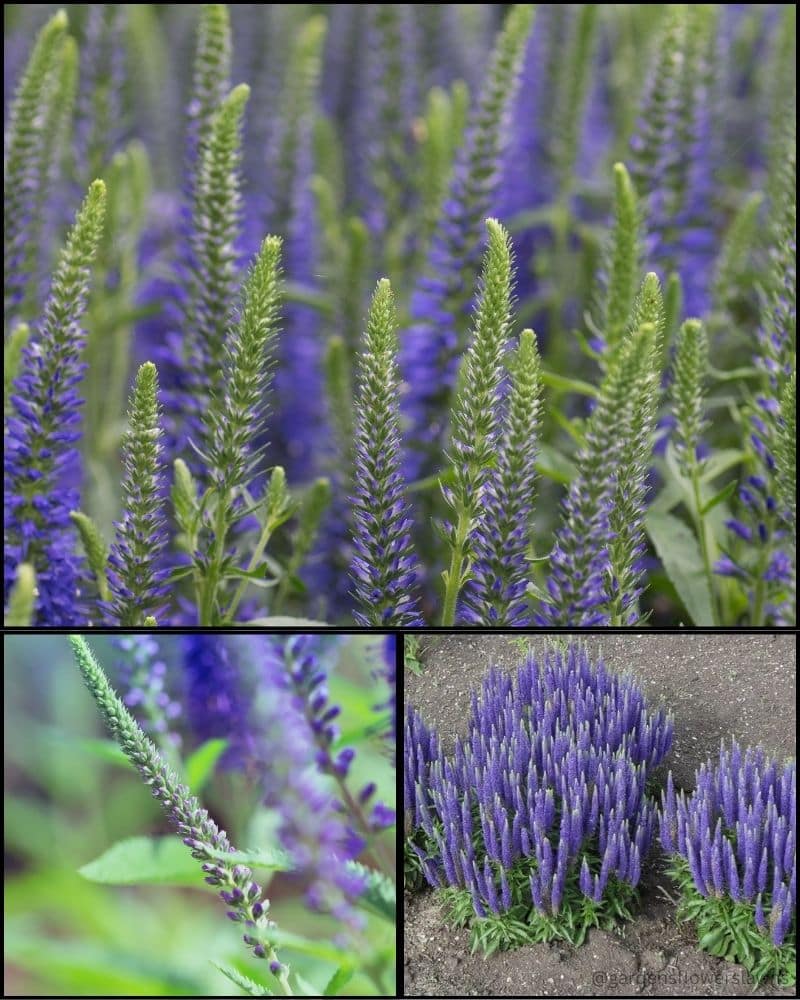
| Quick Care Guide | Details |
|---|---|
| Climate Zones | USDA Zones 4-8 |
| Sun Requirements | Full sun to partial shade |
| Soil | Well-drained; tolerates a range of soil types |
| Watering Needs | Moderate; consistent moisture is preferred but avoid overwatering |
| Common Companion Plants | Coneflowers (Echinacea), Shasta Daisies, Yarrow, Salvias, and Black-Eyed Susans (Rudbeckia) |
Speedwell, also known as Veronica, is a versatile perennial with varieties that range from compact ground covers to stately flower spikes.
With blooms in shades of blue, purple, and pink, Speedwell adds elegance and color to garden beds, borders, and containers.
While some types can be invasive, choosing the right variety ensures a controlled and harmonious addition to your landscape.
This hardy plant thrives in well-drained soil and enjoys full to partial sun. Its minimal care requirements and adaptability make it a popular choice for gardeners seeking low-maintenance beauty.
For best results, consult local gardening experts to select non-aggressive types, and enjoy the vibrant charm that Speedwell brings to your outdoor spaces.
Catmint: Fragrant Beauty Without the Cat Chaos
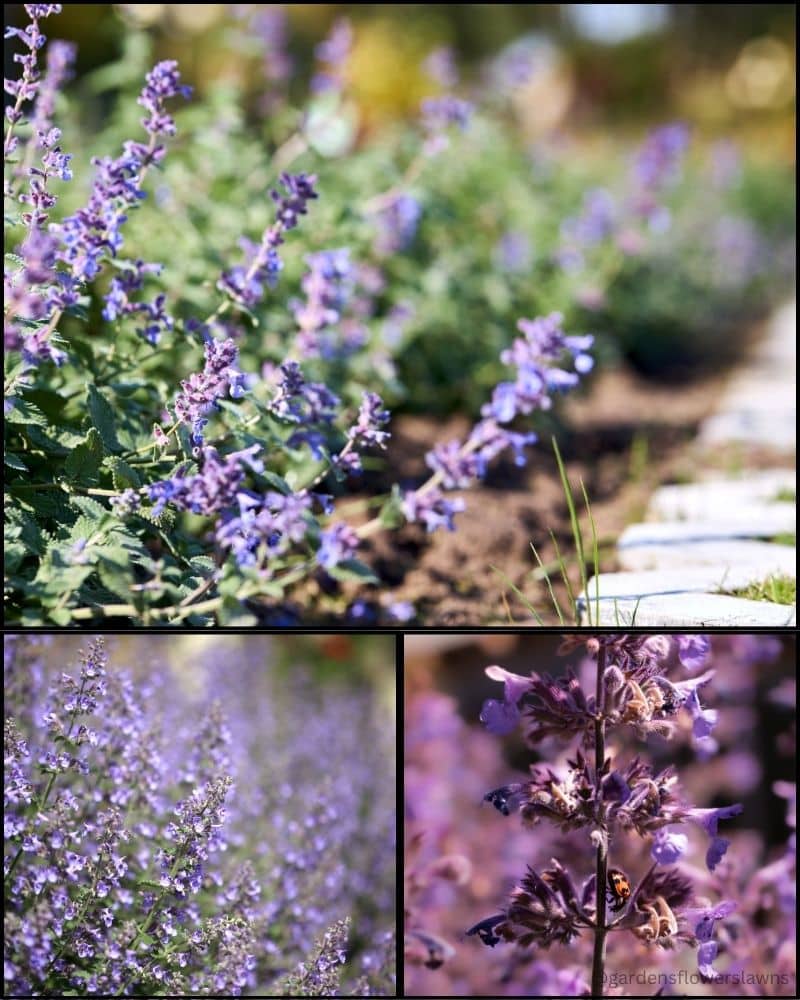
| Quick Care Guide | Details |
|---|---|
| Climate Zones | USDA Zones 4-9 |
| Sun Requirements | Full sun to partial shade |
| Soil | Well-drained; tolerates sandy or rocky soils |
| Watering Needs | Low to moderate; drought-tolerant once established |
| Common Companion Plants | Lavender, Yarrow, Coreopsis, Black-Eyed Susans (Rudbeckia), and Coneflowers (Echinacea) |
Catmint (Nepeta x Faassenii) is a garden favorite, loved for its silvery-grey foliage and soft lavender-purple blooms.
Unlike its relative catnip, catmint doesn’t attract neighborhood cats, but it does draw in bees and butterflies, making it a great choice for pollinator-friendly gardens.
Its long blooming season and aromatic foliage make it a standout in borders, herb gardens, or as a low-growing hedge.
This resilient perennial thrives in well-drained soil and sunny to partially shaded locations. With minimal care, catmint rewards gardeners with continuous color and fragrance.
Its drought tolerance and easy maintenance make it an ideal choice for enhancing any garden with beauty and charm. Regular deadheading will keep the flowers coming, ensuring a vibrant display all season long.
Blanket Flower: A Burst of Sunset in Your Garden
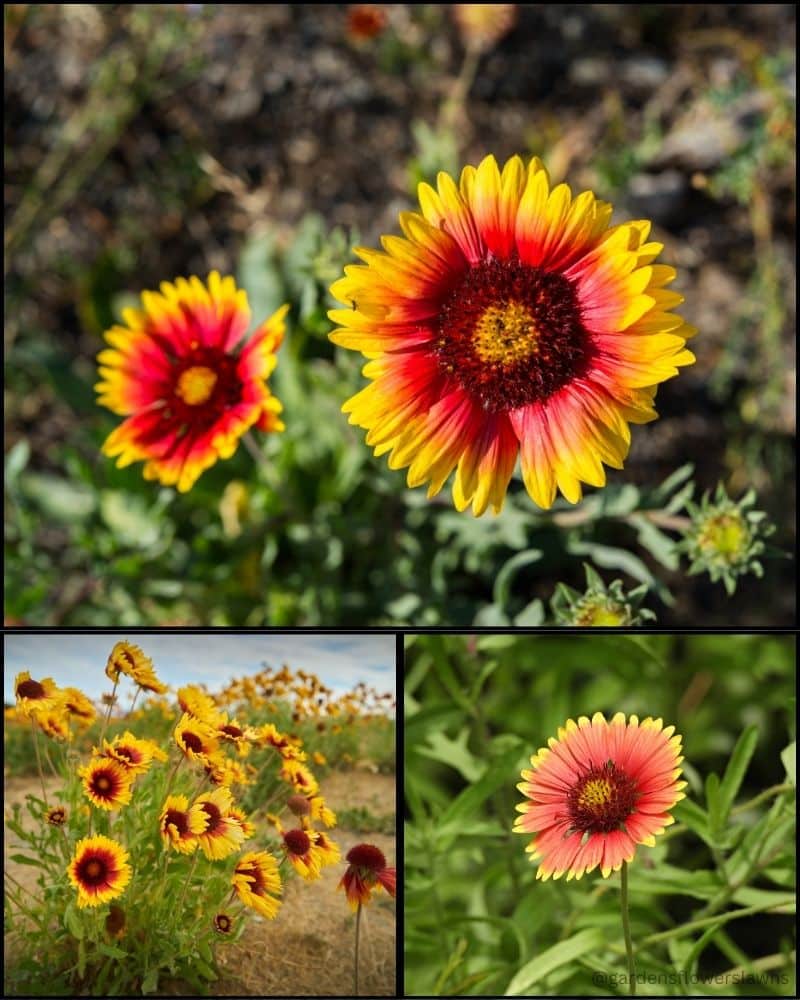
| Quick Care Guide | Details |
|---|---|
| Climate Zones | USDA Zones 3-10 |
| Sun Requirements | Full sun |
| Soil | Well-drained; tolerates sandy or rocky soils |
| Watering Needs | Low; drought-tolerant once established |
| Common Companion Plants | Yarrow, Coneflowers (Echinacea), Coreopsis, Black-Eyed Susans (Rudbeckia), and Salvias |
Blanket Flowers (Gaillardia) are a dazzling addition to any sunny garden, featuring bold blooms in fiery shades of red, orange, and yellow.
Their vibrant colors evoke the warmth of a desert sunset, while their resilience makes them perfect for challenging climates.
These perennials thrive in drought and heat, flowering profusely throughout the season with minimal care.
The dense, dark green foliage provides a rich backdrop for the flowers’ tapestry of color. For the best results, plant Blanket Flowers in full sun and well-drained soil.
Their ability to flourish in tough conditions and their long-lasting blooms make them a joyful and low-maintenance choice for borders, wildflower gardens, or containers.
Creeping Phlox: A Vibrant Groundcover Winner

| Quick Care Guide | Details |
|---|---|
| Climate Zones | USDA Zones 3-9 |
| Sun Requirements | Partial sun to full sun |
| Soil | Well-drained; prefers slightly sandy or rocky soil |
| Watering Needs | Moderate; consistent moisture during establishment, drought-tolerant once mature |
| Common Companion Plants | Daylilies, Black-Eyed Susans (Rudbeckia), Coneflowers (Echinacea), and Sedum |
Creeping Phlox is a stunning groundcover perennial, creating a dense floral carpet in hues of pink, purple, white, and blue.
Its cascading blooms herald the arrival of spring, filling garden crevices, softening rocky slopes, or brightening the base of trees with vibrant color.
This hardy plant, native to North America and Siberia, thrives in cool climates and returns reliably each year.
For optimal growth, plant Creeping Phlox in well-drained soil with partial to full sun exposure. Its adaptability, combined with its low-maintenance needs, makes it an excellent choice for gardeners looking to add beauty and functionality to their landscapes.
Whether spilling over garden edges or enhancing a rock garden, Creeping Phlox brings lasting charm and vibrant color.
Million Bells: Cascading Blooms for Every Space (An Annual, But Easy)
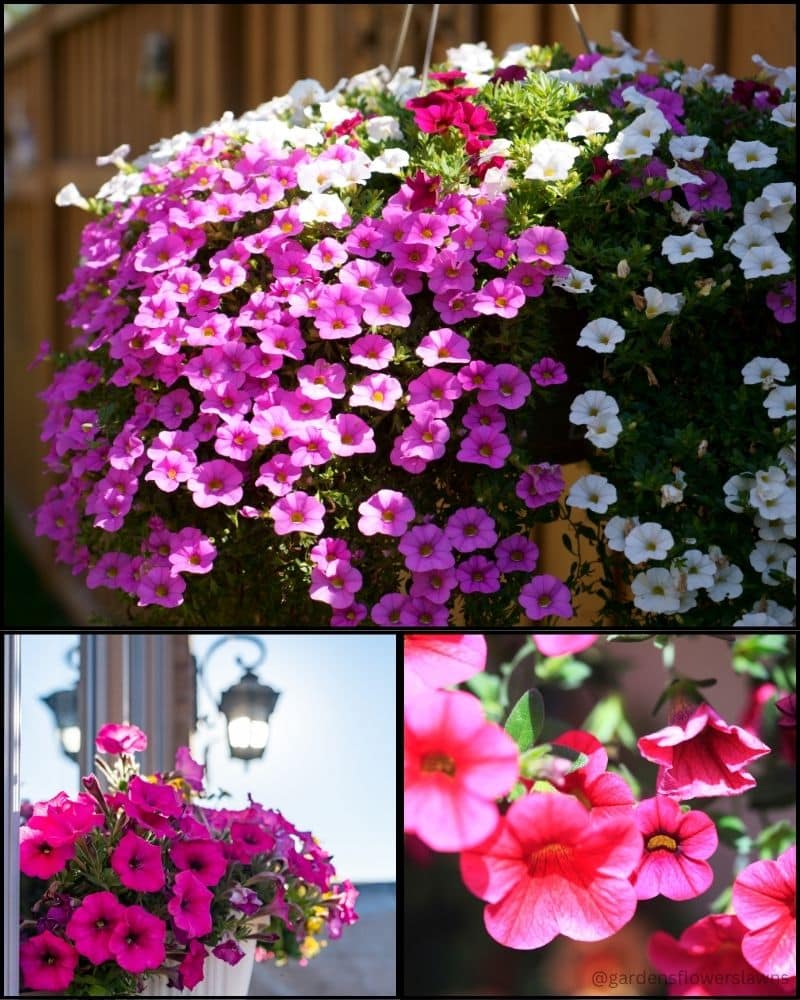
| Quick Care Guide | Details |
|---|---|
| Climate Zones | Best grown as an annual in USDA Zones 9-11, but widely used as a seasonal plant in all zones |
| Sun Requirements | Full sun |
| Soil | Well-drained, rich in organic matter |
| Watering Needs | Moderate; prefers consistent moisture but avoids waterlogging |
| Common Companion Plants | Sweet Alyssum, Lobelia, Petunias, Verbena, and Trailing Ivy |
Million Bells (Calibrachoa) bring a cascade of vibrant color to your garden, with blooms resembling miniature petunias in a stunning variety of shades and patterns.
Perfect for containers, hanging baskets, and garden borders, these flowers deliver continuous color from spring through fall, creating high-impact displays.
For the best results, plant Million Bells in well-drained soil with full sun exposure. Mixing multiple colors in a single arrangement adds visual appeal, while regular feeding and occasional deadheading ensure a profusion of blooms.
Their trailing habit makes them ideal for brightening up patios, enhancing balcony railings, or adding flair to garden edges. With minimal effort, Million Bells will bring season-long beauty to your outdoor spaces.
Pentas: Starry Blooms for a Vibrant Summer

| Quick Care Guide | Details |
|---|---|
| Climate Zones | USDA Zones 9-11 (grown as an annual in cooler zones) |
| Sun Requirements | Full sun to partial shade |
| Soil | Well-drained, enriched with organic matter |
| Watering Needs | Moderate; water regularly, especially during hot, dry periods |
| Common Companion Plants | Lantana, Zinnias, Marigolds, Salvia, and Verbena |
Pentas (Pentas lanceolata) are warm-weather garden stars, showcasing clusters of star-shaped flowers in vibrant hues like white, red, pink, and purple.
These eye-catching blooms are butterfly and hummingbird magnets, ensuring your garden is alive with activity all summer long.
Pentas are versatile and thrive in both full sun and partial shade, making them suitable for garden beds, borders, or containers.
To keep them blooming, plant in well-drained soil, water consistently, and apply a balanced, slow-release fertilizer.
Regular deadheading will encourage new flowers, ensuring a season-long display of these cheerful and resilient plants. Whether as a border or a container filler, Pentas are a brilliant choice for adding lasting color to your garden.
Ornamental Kale: A Cool-Season Showstopper
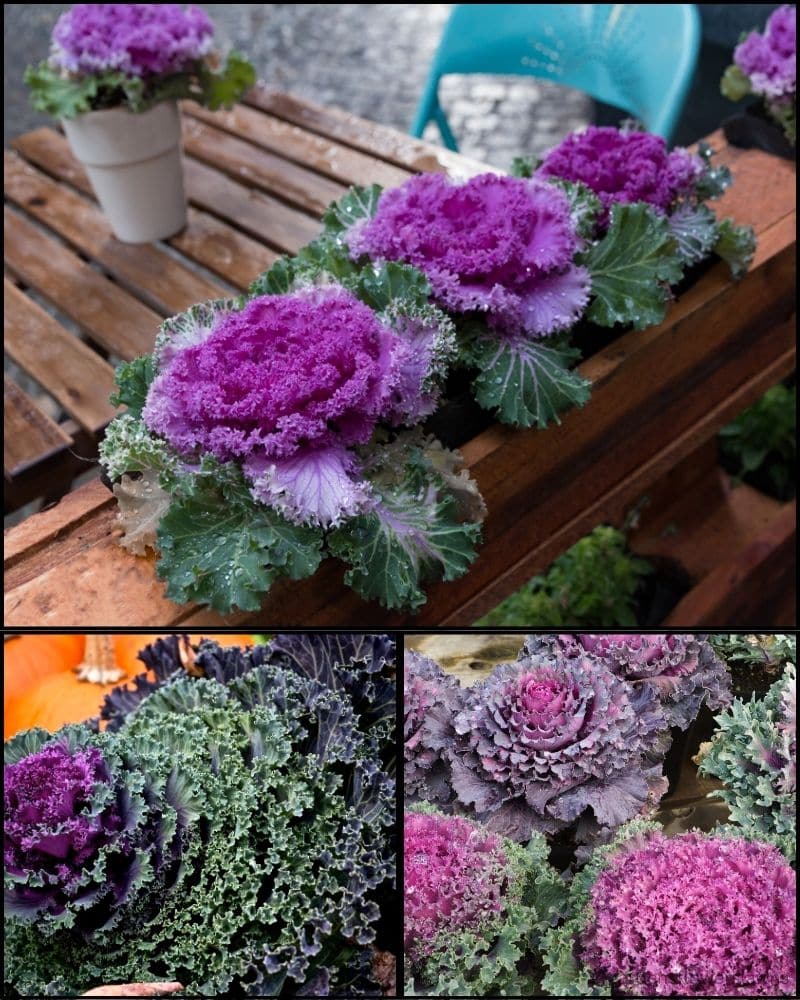
| Quick Care Guide | Details |
|---|---|
| Climate Zones | USDA Zones 2-11 (grown as an annual) |
| Sun Requirements | Full sun to partial shade |
| Soil | Well-drained, enriched with organic compost |
| Watering Needs | Moderate; keep soil consistently moist but not waterlogged |
| Common Companion Plants | Pansies, Violas, Dusty Miller, Chrysanthemums, and Snapdragons |
Ornamental Kale (Brassica oleracea) transforms autumn and winter gardens with its vibrant rosettes of colorful foliage in shades of white, pink, purple, and green.
This hardy cool-season plant thrives as temperatures drop, offering a bold and textured contrast to the muted tones of the colder months.
Ideal for garden borders or as a centerpiece in fall container arrangements, Ornamental Kale is as versatile as it is beautiful.
Plant it in a sunny location with soil enriched by organic compost, and enjoy its striking aesthetic. While primarily grown for its decorative leaves,
Ornamental Kale is edible, adding both color and a mild flavor to winter dishes. It’s a standout choice for extending garden interest well into the cooler seasons.
Dusty Miller: Silvery Elegance for Every Garden

| Quick Care Guide | Details |
|---|---|
| Climate Zones | USDA Zones 8-11 (grown as an annual in cooler climates) |
| Sun Requirements | Full sun to partial shade |
| Soil | Well-drained, moderately fertile |
| Watering Needs | Low to moderate; drought-tolerant once established |
| Common Companion Plants | Petunias, Marigolds, Zinnias, Snapdragons, and Ornamental Kale |
Dusty Miller (Senecio cineraria) is a gardener’s favorite for its striking silvery-gray foliage that adds a touch of sophistication to any planting scheme.
Its soft, finely textured leaves contrast beautifully with vibrant flowers, creating depth and visual interest in garden beds, borders, and containers.
This hardy plant thrives in well-drained soil and full sun, though it tolerates partial shade. Perfect for edging pathways or accentuating mixed flower beds, Dusty Miller requires minimal care.
Occasional pruning helps maintain its neat and bushy appearance, ensuring year-round elegance in warmer climates or seasonal beauty in cooler ones.
Its resilience and versatility make it an indispensable choice for any garden.
Cora Vinca: Resilient Blooms for Hot Climates (Zones 9-11)

| Quick Care Guide | Details |
|---|---|
| Climate Zones | USDA Zones 9-11 (grown as an annual in cooler climates) |
| Sun Requirements | Full sun |
| Soil | Well-drained; tolerates sandy and slightly nutrient-poor soils |
| Watering Needs | Moderate; water during dry spells, but avoid overwatering |
| Common Companion Plants | Lantana, Zinnias, Marigolds, Portulaca, and Pentas |
Cora Vinca (Catharanthus roseus) is a heat-loving powerhouse that thrives in the hottest, sunniest conditions where other plants might wilt.
With glossy dark green leaves and a profusion of blooms in shades of pink, white, red, and purple, this hardy plant brings continuous color to your garden all season long.
Its disease resistance, particularly to root rot, sets it apart as a reliable choice for challenging environments.
For the best results, plant Cora Vinca in well-drained soil in a sunny spot. These low-maintenance flowers are ideal for rock gardens, borders, or areas requiring minimal care.
While regular watering during dry periods keeps them vibrant, deadheading isn’t necessary—Cora Vincas bloom profusely without additional effort, making them a hassle-free addition to any garden.
Aquilegia McKana Giants Mix: Whimsical Blooms for Cooler Gardens

| Quick Care Guide | Details |
|---|---|
| Climate Zones | USDA Zones 3-9 |
| Sun Requirements | Partial shade; tolerates morning sun |
| Soil | Moist, well-drained; rich in organic matter |
| Watering Needs | Moderate; consistent moisture, especially during dry periods |
| Common Companion Plants | Hostas, Astilbe, Bleeding Hearts, Ferns, and Coral Bells (Heuchera) |
Aquilegia McKana Giants Mix, a standout member of the columbine family, is a feast for the eyes with its striking spurred blooms in shades of blue, pink, yellow, and white.
These enchanting flowers bring a whimsical touch to temperate gardens, and their nectar-rich blooms are a favorite for hummingbirds and butterflies.
To thrive, plant McKana Giants in moist, well-drained soil with partial shade, shielding them from the intense afternoon sun.
Perfect for woodland gardens or mixed perennial borders, they add vibrant color and charm each spring.
Deadhead the flowers to prolong their blooming season and encourage new growth, or allow a few to go to seed for natural reseeding and a magical return year after year.
Butterfly Weed: A Pollinator Magnet with Stunning Color

| Quick Care Guide | Details |
|---|---|
| Climate Zones | USDA Zones 3-9 |
| Sun Requirements | Full sun |
| Soil | Well-drained; thrives in poor to average soil |
| Watering Needs | Low; highly drought-tolerant once established |
| Common Companion Plants | Coneflowers (Echinacea), Black-Eyed Susans (Rudbeckia), Yarrow, Coreopsis, and Blanket Flowers (Gaillardia) |
Butterfly Weed (Asclepias tuberosa) dazzles with its bright orange clusters of flowers, adding a vibrant touch to any garden.
Beyond its beauty, this perennial is a critical food source for monarch butterflies and a magnet for bees and other pollinators, making it a must-have for butterfly gardens and eco-friendly landscapes.
This low-maintenance plant thrives in full sun and well-drained soil, even tolerating poor or rocky conditions.
Butterfly Weed’s drought tolerance makes it an excellent choice for xeriscaping or sunny, dry areas of your yard. To ensure healthy growth, plant in soil that isn’t overly rich and provide space for natural spreading.
Its bold blooms and ecological benefits make it a standout addition to any garden.
Pansies: Cheerful Blooms for Every Season

| Quick Care Guide | Details |
|---|---|
| Climate Zones | USDA Zones 6-10 (grown as annuals in most regions) |
| Sun Requirements | Full sun to partial shade |
| Soil | Moist, well-drained; enriched with organic matter |
| Watering Needs | Moderate; consistent moisture, especially in warmer climates |
| Common Companion Plants | Violas, Snapdragons, Dusty Miller, Ornamental Kale, and Spring Bulbs |
Pansies (Viola × wittrockiana) bring bursts of vibrant color to gardens year-round, thriving in cooler seasons when other blooms fade.
Their signature face-like flowers appear in a range of purples, yellows, blues, and more, making them a versatile choice for garden beds, containers, and even edible displays.
Plant pansies in moist, well-drained soil with full to partial sun exposure for the best results. Adding mulch helps keep roots cool and soil moist, extending their blooming season.
Regular deadheading encourages continuous flowers, ensuring a lively, colorful display throughout the growing season.
Whether brightening garden borders or adorning salads as a decorative garnish, pansies are a gardener’s delight.
Astilbe: A Stunning Highlight for Shaded Spaces

| Quick Care Guide | Details |
|---|---|
| Climate Zones | USDA Zones 4-9 |
| Sun Requirements | Partial to full shade |
| Soil | Moist, well-drained, rich in organic matter |
| Watering Needs | Moderate to high; keep soil consistently moist |
| Common Companion Plants | Hostas, Ferns, Coral Bells (Heuchera), Bleeding Hearts, and Japanese Forest Grass |
Astilbe is a showstopper in shaded gardens, known for its feathery plumes of flowers that add vibrant splashes of color to dim spaces.
Blooming in shades of white, pink, red, and deep purple, these perennials bring elegance and texture to garden beds and borders, creating a magical, lively ambiance.
Astilbe thrives in moist, well-drained soil enriched with organic matter, making it a reliable choice for shaded or woodland gardens.
Regular watering ensures its lush growth and breathtaking blooms. Perfect for pairing with other shade-loving plants like ferns and hostas, Astilbe elevates any garden with its unique charm and bold color.
Peonies: Luxurious Blooms for Spring Elegance

| Quick Care Guide | Details |
|---|---|
| Climate Zones | USDA Zones 3-8 |
| Sun Requirements | Full sun to partial shade |
| Soil | Well-drained, rich, and fertile |
| Watering Needs | Moderate; keep soil moist but not waterlogged |
| Common Companion Plants | Irises, Salvia, Foxglove, Hardy Geraniums, and Shasta Daisies |
Peonies are the epitome of garden luxury, featuring large, fragrant blooms in shades of pink, red, white, and even yellow.
Their lush, showy flowers appear in late spring, making them a timeless favorite for garden beds and cut flower arrangements.
These perennials thrive in sunny to lightly shaded spots with rich, well-drained soil. Once established, peonies require minimal maintenance, often living and blooming for decades.
For the best results, plant peonies with the crown just below the soil surface, provide moderate watering, and stake taller varieties to support the heavy blooms. Their bold beauty and long lifespan make peonies a cornerstone of elegant garden design.
Japanese Anemones: Graceful Fall Bloomers

| Quick Care Guide | Details |
|---|---|
| Climate Zones | USDA Zones 4-8 |
| Sun Requirements | Partial shade to full sun (prefers afternoon shade in warmer climates) |
| Soil | Moist, well-drained, rich in organic matter |
| Watering Needs | Moderate; keep soil consistently moist, especially during dry spells |
| Common Companion Plants | Astilbe, Hostas, Bleeding Hearts, Ferns, and Hardy Geraniums |
Japanese Anemones bring a touch of elegance to late summer and fall gardens, with their delicate, cup-shaped blooms in shades of white, pink, and mauve.
Standing tall on slender stems, these graceful perennials create a dynamic visual display and complement other late-season plants.
Ideal for woodland gardens and shaded borders, Japanese Anemones thrive in moist, well-drained soil enriched with organic matter.
They prefer partial shade, particularly in hotter climates, to protect them from intense afternoon sun.
With minimal maintenance and excellent tolerance for cooler temperatures, these blooms offer enduring charm as the garden transitions into fall. Deadheading spent flowers can encourage a prolonged blooming season.
Hardy Geraniums: Versatile and Reliable Blooms

| Quick Care Guide | Details |
|---|---|
| Climate Zones | USDA Zones 4-8 |
| Sun Requirements | Full sun to partial shade |
| Soil | Well-drained, moderately fertile |
| Watering Needs | Moderate; keep soil moist but avoid overwatering |
| Common Companion Plants | Salvia, Coneflowers (Echinacea), Yarrow, Foxglove, and Shasta Daisies |
Hardy Geraniums, often called cranesbills, are dependable perennials known for their delicate, five-petaled flowers and mounding foliage.
Blooming in a wide range of colors, including pink, blue, white, and purple, these plants add charm to borders, rock gardens, and woodland edges.
They thrive in well-drained soil and tolerate both full sun and partial shade, making them versatile additions to most garden settings.
Hardy Geraniums are easy to care for, requiring only occasional deadheading to encourage continuous blooms.
Their sprawling habit can also help suppress weeds, making them a functional and beautiful ground cover option. These perennials are perfect for bringing consistent color and texture to your garden.
Baptisia (False Indigo): A Native Beauty with Striking Spikes

| Quick Care Guide | Details |
|---|---|
| Climate Zones | USDA Zones 3-9 |
| Sun Requirements | Full sun to light shade |
| Soil | Well-drained; thrives in poor to average soil |
| Watering Needs | Low to moderate; drought-tolerant once established |
| Common Companion Plants | Coneflowers (Echinacea), Yarrow, Salvia, Russian Sage, and Ornamental Grasses |
Baptisia, commonly known as False Indigo, is a standout perennial prized for its tall, spiky flowers in shades of blue, purple, white, and yellow.
A native plant in North America, Baptisia is a robust and long-lived addition to any garden, offering bold vertical interest and striking blooms in late spring to early summer.
This low-maintenance plant thrives in full sun and tolerates poor soil, making it ideal for challenging garden conditions. Once established, Baptisia is drought-tolerant and requires little care.
Its bushy growth habit and attractive seed pods add year-round interest, making it a versatile choice for borders, wildflower gardens, or as a focal point in perennial beds. Regular pruning isn’t necessary, but cutting back spent flower spikes can tidy up its appearance.
Hellebores (Lenten Rose): Early Bloomers for Shade Gardens

| Quick Care Guide | Details |
|---|---|
| Climate Zones | USDA Zones 4-9 |
| Sun Requirements | Partial to full shade |
| Soil | Moist, well-drained, rich in organic matter |
| Watering Needs | Moderate; prefers consistent moisture |
| Common Companion Plants | Ferns, Hostas, Astilbe, Bleeding Hearts, and Japanese Anemones |
Hellebores, commonly known as Lenten Roses, are cherished for their elegant, nodding blooms that appear in late winter to early spring.
Their flowers, in shades of white, pink, purple, and green, often feature speckled or veined patterns, adding subtle beauty to shaded garden spaces.
Perfect for woodland gardens or shaded borders, Hellebores thrive in moist, well-drained soil rich in organic matter.
These low-maintenance perennials are deer-resistant and evergreen in many climates, providing year-round foliage interest.
To encourage healthy growth and vibrant blooms, remove old or damaged leaves before the flowering season begins. With their early blooms and refined charm, Hellebores are a standout in any shade-loving garden.
Russian Sage: A Hardy and Elegant Garden Performer

| Quick Care Guide | Details |
|---|---|
| Climate Zones | USDA Zones 4-9 |
| Sun Requirements | Full sun |
| Soil | Well-drained; tolerates poor and sandy soils |
| Watering Needs | Low; drought-tolerant once established |
| Common Companion Plants | Coneflowers (Echinacea), Black-Eyed Susans (Rudbeckia), Yarrow, Coreopsis, and Blanket Flowers (Gaillardia) |
Russian Sage (Perovskia atriplicifolia) is a hardy perennial that brings texture, color, and resilience to sunny gardens.
With its silvery-gray foliage and tall spires of lavender-blue flowers, it creates a soft, airy effect perfect for borders, cottage gardens, or xeriscaping.
Thriving in full sun and well-drained soil, Russian Sage is drought-tolerant and thrives in challenging conditions, including poor and sandy soils.
Its fragrant foliage deters deer and rabbits, while its blooms attract pollinators like bees and butterflies. Minimal maintenance is required—cut it back in early spring to encourage fresh growth and fuller blooms.
With its long-lasting color and adaptability, Russian Sage is a reliable choice for any low-maintenance garden.
Bleeding Hearts (Dicentra): Romantic Elegance for Shaded Gardens
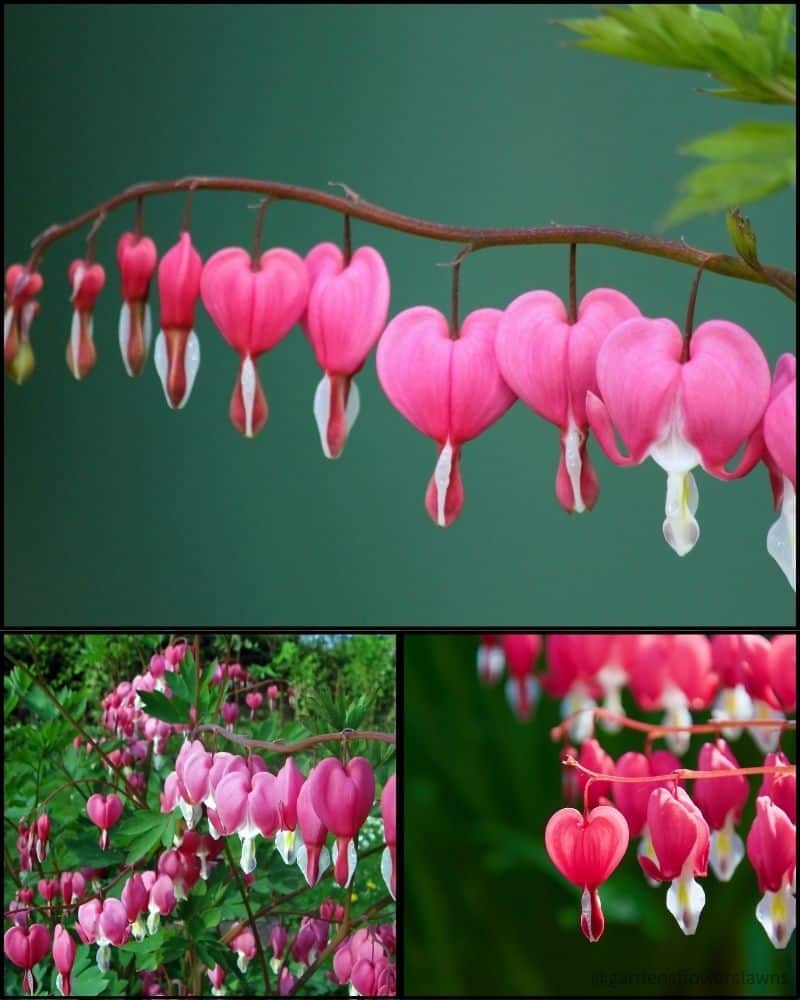
| Quick Care Guide | Details |
|---|---|
| Climate Zones | USDA Zones 3-9 |
| Sun Requirements | Partial to full shade |
| Soil | Moist, well-drained, rich in organic matter |
| Watering Needs | Moderate; keep soil evenly moist |
| Common Companion Plants | Hostas, Astilbe, Ferns, Coral Bells (Heuchera), and Japanese Anemones |
Bleeding Hearts (Dicentra) are known for their enchanting heart-shaped flowers that dangle gracefully along arching stems, creating a romantic and whimsical display in spring gardens.
Available in shades of pink, white, and red, these delicate blooms bring elegance and charm to shaded borders and woodland gardens.
Thriving in moist, well-drained soil and partial to full shade, Bleeding Hearts prefer cool conditions. They are low-maintenance but may go dormant in midsummer, so pairing them with later-blooming plants can help fill any gaps in your garden.
Deadheading spent flowers can prolong blooming, and regular watering will keep the plants healthy and vibrant. Their timeless beauty makes them a classic choice for shaded garden spaces.
Foxglove (Digitalis): Towering Elegance with Vibrant Spires

| Quick Care Guide | Details |
|---|---|
| Climate Zones | USDA Zones 4-8 |
| Sun Requirements | Full sun to partial shade |
| Soil | Moist, well-drained, rich in organic matter |
| Watering Needs | Moderate; consistent moisture is preferred |
| Common Companion Plants | Delphiniums, Astilbe, Hardy Geraniums, Bleeding Hearts, and Shasta Daisies |
Foxglove (Digitalis) is a striking biennial or perennial known for its tall spikes of tubular flowers, often marked with intricate patterns.
Blooming in shades of purple, pink, yellow, and white, these towering plants add vertical drama and classic charm to cottage gardens, woodland edges, and shaded borders.
Thriving in moist, well-drained soil, Foxgloves prefer full sun in cooler climates and partial shade in warmer areas.
They are easy to grow, but gardeners should note that all parts of the plant are toxic if ingested. Regular deadheading can encourage a second flush of blooms, while allowing some flowers to go to seed ensures self-sowing for future seasons. Their graceful spires make Foxglove a stunning addition to any garden.
Delphiniums: Majestic Spires for a Dramatic Garden Display

| Quick Care Guide | Details |
|---|---|
| Climate Zones | USDA Zones 3-7 |
| Sun Requirements | Full sun to light shade (prefers afternoon shade in hot climates) |
| Soil | Moist, well-drained, rich in organic matter |
| Watering Needs | Moderate; consistent moisture is essential |
| Common Companion Plants | Foxgloves, Shasta Daisies, Peonies, Astilbe, and Hardy Geraniums |
Delphiniums are known for their stately spikes of vibrant flowers that tower above other garden plants. Blooming in shades of blue, purple, pink, white, and lavender, these perennials bring a touch of grandeur to borders, cottage gardens, and cutting gardens.
Delphiniums thrive in moist, well-drained soil enriched with organic matter. They prefer cooler climates and benefit from protection from harsh afternoon sun in warmer areas.
Staking is often necessary to support their tall, heavy flower spikes, especially in windy conditions. Regular deadheading encourages a second flush of blooms, extending their flowering season.
With their bold height and stunning colors, Delphiniums are a must-have for creating dramatic garden landscapes.
Dianthus: Compact Blooms with Fragrant Charm

| Quick Care Guide | Details |
|---|---|
| Climate Zones | USDA Zones 4-9 |
| Sun Requirements | Full sun |
| Soil | Well-drained, slightly alkaline, and fertile |
| Watering Needs | Moderate; avoid overwatering |
| Common Companion Plants | Lavender, Shasta Daisies, Coreopsis, Salvia, and Ornamental Grasses |
Dianthus, commonly known as “pinks,” “Sweet William,” or “carnations,” are compact perennials, biennials, or annuals cherished for their fringed petals and delightful clove-like fragrance.
Available in shades of pink, white, red, and bicolor combinations, they are perfect for borders, rock gardens, or container displays.
These low-maintenance plants thrive in full sun and well-drained, slightly alkaline soil. Regular deadheading prolongs blooming and keeps the plants looking neat.
Dianthus are drought-tolerant once established, making them a practical choice for sunny spots with dry conditions. Their vibrant, fragrant blooms and easy care make them a favorite for cottage gardens and floral arrangements alike.
Ornamental Grasses: Texture and Movement for Any Landscape

| Quick Care Guide | Details |
|---|---|
| Climate Zones | Varies by species (commonly USDA Zones 4-9) |
| Sun Requirements | Full sun to partial shade (species-dependent) |
| Soil | Well-drained; adaptable to a variety of soil types |
| Watering Needs | Low to moderate; drought-tolerant varieties available |
| Common Companion Plants | Coneflowers (Echinacea), Black-Eyed Susans (Rudbeckia), Russian Sage, Coreopsis, and Sedum |
Ornamental grasses bring a unique blend of texture, movement, and structure to gardens. From the flowing plumes of Pampas Grass to the fine, upright blades of Blue Fescue, these versatile plants add visual interest throughout the growing season and even into winter.
These grasses thrive in well-drained soil and a sunny location, though some species tolerate partial shade.
They are typically low-maintenance, requiring minimal watering and care. In late winter or early spring, cut back grasses to encourage fresh growth.
Perfect for borders, rock gardens, or mass plantings, ornamental grasses also pair beautifully with vibrant perennials, enhancing the overall design of your landscape. Their resilience and year-round appeal make them a garden staple.
Artemisia: Silvery Foliage for Sophisticated Contrast

| Quick Care Guide | Details |
|---|---|
| Climate Zones | USDA Zones 4-8 |
| Sun Requirements | Full sun |
| Soil | Well-drained, sandy, or rocky soils |
| Watering Needs | Low; drought-tolerant once established |
| Common Companion Plants | Lavender, Coneflowers (Echinacea), Russian Sage, Salvia, and Ornamental Grasses |
Artemisia, often called Wormwood, is known for its silvery-gray foliage that adds soft contrast and texture to garden designs.
Its feathery, aromatic leaves pair beautifully with brightly colored flowers, creating a sophisticated balance in borders, rock gardens, or containers.
This hardy perennial thrives in sunny, dry conditions and requires minimal care once established. Artemisia prefers well-drained soils and can tolerate poor, sandy, or rocky sites.
Regular pruning can help maintain its compact shape and prevent legginess. Its drought tolerance and deer resistance make Artemisia an excellent choice for low-maintenance gardens, while its striking foliage enhances the beauty of any planting scheme.
Asters: Vibrant Blooms for Fall Gardens
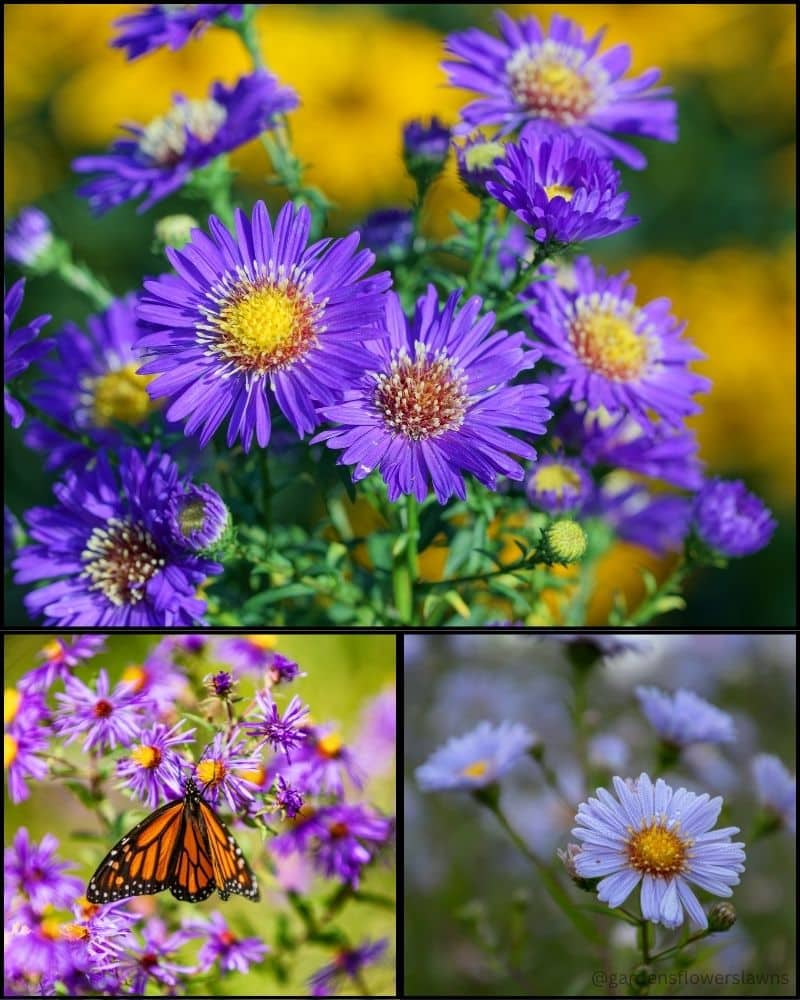
| Quick Care Guide | Details |
|---|---|
| Climate Zones | USDA Zones 3-8 |
| Sun Requirements | Full sun to partial shade |
| Soil | Well-drained, moderately fertile |
| Watering Needs | Moderate; keep soil evenly moist but avoid waterlogging |
| Common Companion Plants | Goldenrod, Sedum, Coneflowers (Echinacea), Black-Eyed Susans (Rudbeckia), and Ornamental Grasses |
Asters are a fall garden favorite, showcasing clusters of daisy-like flowers in vibrant shades of purple, blue, pink, and white.
These perennials bloom late in the season, providing essential nectar for pollinators like bees and butterflies as other flowers fade.
Asters thrive in sunny spots with well-drained soil and benefit from regular watering during dry periods. Pinching back stems in early summer encourages bushier growth and more blooms.
Their versatility makes them perfect for borders, cottage gardens, or wildflower meadows. With their long-lasting beauty and ability to extend the blooming season, Asters are an indispensable choice for any garden.